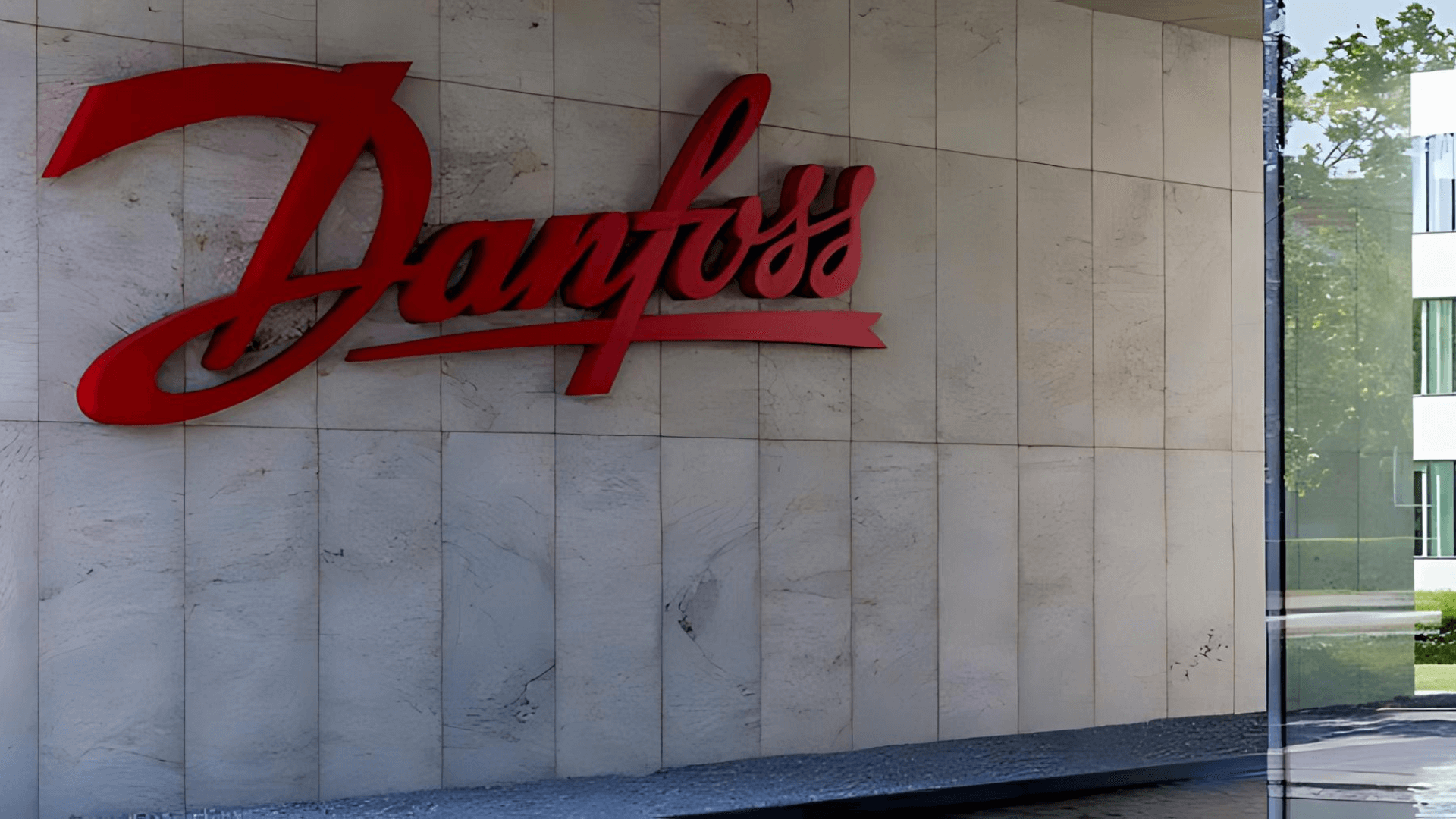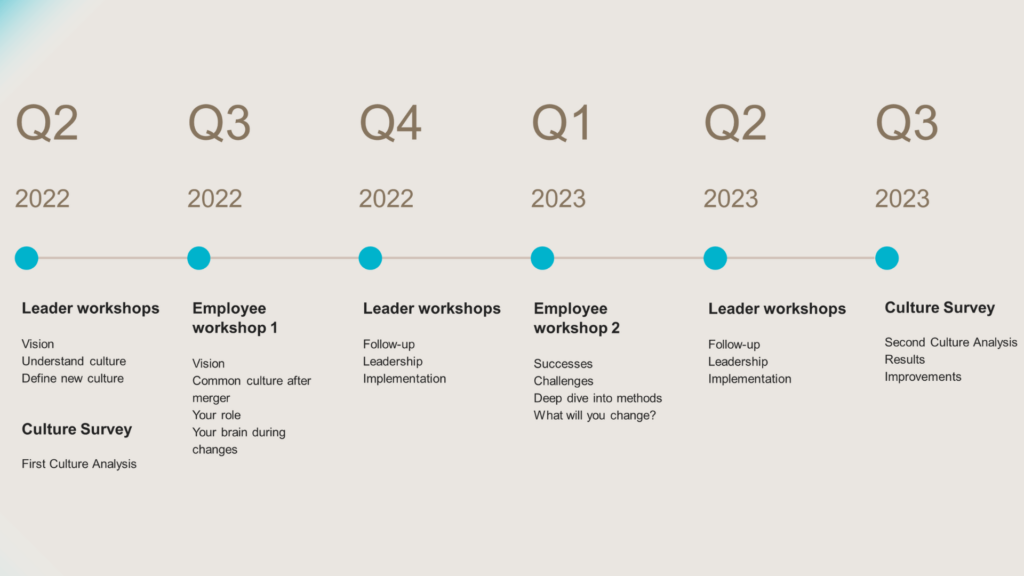Case story
Merging Two Danfoss Factories: Success with a New Shared Culture

Who is Danfoss?
Danfoss is a world leader in developing energy-efficient technologies that help create a better indoor climate in buildings and reduce food waste.
Danfoss' Challenge and Goal
Is it possible to merge two factories while also increasing job satisfaction, culture, and efficiency?
That was the challenge faced by Danfoss Climate Solutions. The production facilities in Viby and Silkeborg were to be merged into a new factory in Silkeborg.
Not only were two productions to be merged into one efficient operation, but half of the employees would also work in a different city than before.
This was a multi-million DKK investment that needed to succeed from day one – and it was crucial that all employees would choose to move from Viby to Silkeborg.
Most importantly, there were already impressive results in the two productions that Danfoss did not want to risk losing during the merger.
Therefore, we focused sharply on developing a shared culture, shared goals, and a shared language to create a solid foundation for the merger, starting well before the physical merging, which was to be executed over the course of a year.
We had two strong cultures. One in Silkeborg and one in Viby (…) We wanted them to merge into a common culture. It was not to be a Silkeborg culture. It was not to be a Viby culture either, (Claus Hjerrild, Head of Operations, Danfoss Silkeborg).
An Insight into the Process: How We Did It
Any major change process in an organization demands attention to culture, leadership, collaboration, and investment from the employees’ side.
It requires us to “unlock” existing mindsets and behaviors, implement the change, and “relock” the new behavior.
So, how do we get everyone on board and pulling in the same direction, while job satisfaction and engagement increase amid a change process?
At Danfoss, the challenge was to merge two strong cultures. Additionally, there was a strong trade union organization, which not only made great demands on the process and planning but also on the leaders who were to drive it.
Therefore, we added a few important ingredients to the process. Some that are often overlooked. We involved all union representatives, who participated in the exact same workshops as the leaders.
Another ingredient was involving all employees in workshops with just the right timing – long before the actual change began.
This contributed to a strong ownership of the process, fantastic cohesion, and good cross-departmental cooperation. A crucial factor to ensure that everyone engaged and maintained a positive and constructive mindset, even when the process was tough, frustrating, and demanding.
To Achieve Our Goals, We Have Worked Together on:
- Merging two strong cultures
- Developing a common culture, common goals, and common language
- Workshops for leaders and union representatives
- Full-day workshops for all employees - without exception
- Culture surveys
- Tools and concepts for daily communication
- Ensuring employee retention and ownership of the process throughout the organization
- Creating a strong starting point that could ensure success from day one
The Solution: Shared Culture, Shared Goals, and Shared Language
Already in Q2 of 2022, we started the process – even though the first part of the relocation wasn’t until Q2 of 2023. So, we began preparing for the mental change in leaders and employees a year before with the goal of creating a strong shared culture that would ensure a smooth merger.
Throughout the process, leader workshops, employee workshops, and culture surveys were all methods repeatedly used.
Get an overview of the various steps in the change process here:

Culture survey
In the process, we conducted two culture surveys. One at the very beginning and one in the middle of the move.
The first culture survey had three purposes. It was to provide a clear starting point, tailor workshops, help us measure progress, and to adjust actions along the way.
We now had an exact picture of a strong culture, where there was still potential to make the culture even stronger in some areas.
Based on the first culture survey, common goals were set, and leaders were trained to work with the culture measurement in their own departments and involve their teams in improvements.
The second survey was conducted in the middle of the move to evaluate how was going. Here we compared the results with those from the first culture survey- and what results they showed.
Workshops
Early in the process, leaders and union representatives were involved to discuss the process. What kind of process are we going through? After that, employees were called to full-day workshops, where leaders and union representatives also participated.
The goal of the various workshops in the process was to create enthusiasm, pride, joy, and alignment about the many changes. They were to create the right mindset – and they were to create it among everyone in the organization.
The dialogues were based on questions like: What is the vision? What culture do we want to create together? What does our culture look like now? What is the gap? What happens in the brain during changes? How do I handle myself in major changes?
To handle these questions, tools, common concepts, common language, and a shared mindset were developed, trained, and implemented, so they could be referred to in daily communication.
Get an insight into the process in the video.
Key Tools
Danfoss has acquired a range of concepts and tools that have become a natural part of daily communication. Concepts and tools that they can lean on for support.
Especially the leaders have received a number of tools they can use – but they have also gained a deep understanding of why the tools work and how to use them in everyday life.
And they are definitely being used.
Especially tools like the Cathedral Builder, Happiness & Productivity, What – Why -How, the Circle of Influence, Green Track & Black Track, Island Visit, and Success Thinking.
Other tools like System 1 & 2 and Unlock-Change-Relock have developed the leaders’ understanding of the change process, and what happens to people in changes. These have been used by leaders in their dialogues with each other.
The toolbox is one of the major reasons Danfoss chose Intenz specifically.
Danfoss' Benefits from the Collaboration
What a journey Danfoss has been on to merge two cultures into one with a common language and common goals.
In the process, culture surveys were a crucial tool to provide a clear picture of the development. And the development in the two culture surveys is outstanding!
“We didn’t start from a bad place. We had a really good culture analysis, where we were a bit above average with two strong cultures. But after a year’s effort we saw that we had moved up to the level corresponding to high-performance. And that’s a big leap in terms of the scale, the culture analysis works with, so we were very impressed by what a year’s effort can move,” (Anne Katrine Bauer, Head of HR, Danfoss Silkeborg).
The second culture survey showed that, against all odds, it was possible to strengthen the culture to a really high level. An amazing result, but particularly remarkable during a change process.
Danfoss can be proud of that, as we often see that major changes negatively affect the culture.
The culture survey result was substantiated by an increase in Danfoss’ own employee engagement measurement. Here too, the result increased significantly and placed Danfoss Silkeborg among the best-performing in the group.
So it succeeded beyond all expectations to merge two good cultures into a common – even stronger – culture.
Another goal was that all employees from Viby should move along to Silkeborg, and everyone in Silkeborg should choose to stay. That succeeded thanks to good preparation and strong efforts.
In fact, Danfoss Silkeborg received the collaboration award from Danish Metal in 2023 for a unique merger with a focus on people.
Summary
In 2022, Danfoss came to us with a challenge. A really exciting one with culture as the focal point.
The production in Viby and the production in Silkeborg were to be merged in 2023, and it had to be a success from day one. The quality had to be maintained, no employees should leave, and the engagement had to remain high.
Therefore, we sharply focused on developing a shared culture, a shared language, and shared goals for the new factory. Already a year before the merger began, we started preparations with culture survey, leader workshops, employee workshops, and implementing tools for use in daily communication.
And what amazing results Danfoss has achieved.
- The culture has been enhanced – even during a major change process
- Culture survey and Danfoss’ own engagement measurement show improved results
- All employees moved along from Viby to Silkeborg
- All plans for the move succeeded according to the plan, and deliveries and quality to customers were met
- Leaders and employees remain positive
- It is easier to attract new employees
- The union representatives nominated Danfoss Silkeborg for the collaboration award at Danish Metal and won
In short: All goals were met, and all challenges were met. A historically good merger that will be hard to beat.
Well done by the entire team Danfoss Silkeborg. Thank you for the collaboration!